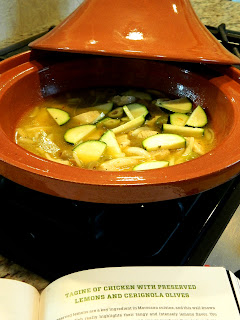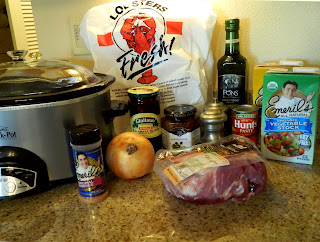This was the first recipe I made from Emeril's cookbook,
Sizzling Skillets and Other One-Pot Wonders and it turned out to be much more aromatic and hearty than expected. I used medium frozen shrimp from a local market, but they were super clean, which is mostly what matters as I hate handling shrimp (but I sure love eating it). I cut all the herbs from my garden and used the last few cloves of garlic, also from our back yard. The Spanish saffron, which came from Bhutan (of all places) via a good friend, lent the stew a somewhat Paella-esque fragrance.

The soup base turned out particularly good, and there ended up being an excess of it. So, I shared some of the stock with my sister who her version of shrimp stew a few days later-- which, she said turned out delicious. I loved this recipe and plan to make it again in the near future-- and I might even attempt to turn it into a type of chili!! (Genevieve, take note for upcoming Chili Competition!!)
Cajun Shrimp Stew
This comforting, simple stew is a Cajun dish that many home
cooks in Louisiana enjoy, especially during the Lenten season. It is easy to
make and feeds a bunch. The trick is getting the roux to the right color . . .
about a notch darker than peanut butter should do the trick. A homemade shrimp
stock makes all the difference in the world. Make sure to add the shrimp just
before serving so that they stay nice and tender. Some families boil eggs in
their shrimp stew (as it simmers) to make the dish even heartier.
1 cup vegetable oil
1 ½ cups all-purpose flour
2 ½ cups finely chopped onion
¼ cup minced garlic (about 12 cloves)
10 cups Rich Shrimp Stock (page 173)
2 bay leaves
1 ¼ teaspoons freshly ground black pepper
¾ teaspoon cayenne
2 teaspoons chopped fresh thyme leaves
1 ½ tablespoons kosher salt
3 large baking potatoes (2 ½ to 3 pounds), peeled and cut
into 2-inch pieces
2 pounds small or medium shrimp, peeled and deveined
¼ cup chopped green onion, green part only
2 tablespoons chopped fresh parsley leaves
Steamed long-grain white rice, for serving
1. Heat the oil in a heavy-bottomed Dutch oven over
medium-high heat and, when hot, add the flour. Whisk to combine and continue to
cook, stirring constantly, until a medium roux is formed (it should look a bit
darker than peanut butter), about 10 minutes. (If the roux begins to brown too
quickly, reduce the heat to medium or medium-low and take your time—it is
important that the roux not be burned at all or the stew will have a bitter
taste.) As soon as the roux is the right color, add the chopped onion and cook
until soft, stirring occasionally, 4 to 6 minutes.
Add the garlic and cook for 2 minutes. Stir in the stock,
little by little, and bring the sauce to a gentle boil. Add the bay leaves,
black pepper, cayenne, thyme, and 4 teaspoons of the salt and reduce the heat
so that the sauce just simmers. Cook, stirring occasionally, until the floury
taste is gone, 30 to 45 minutes.

2. Add the potatoes and continue to cook, uncovered and
stirring occasionally, until the potatoes are very tender and the sauce is
thick and flavorful, 30 to 40 minutes longer. (Add a bit of water or chicken
broth to thin the gravy should the stew get too thick during the cook time. The
sauce is meant to be thick and rich but not pasty.)
3. Toss the shrimp with the remaining ½
teaspoon
salt. Stir the shrimp, green onion, and parsley into the stew and continue to
cook until the shrimp are just cooked through, 3 to 4 minutes. Taste and adjust
the seasoning if necessary. Remove the bay leaves. Serve the stew in shallow
bowls over hot white rice.
6 to 8 servings



















